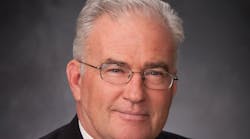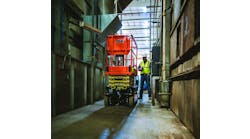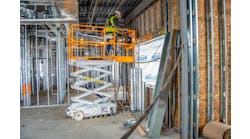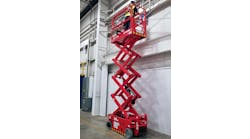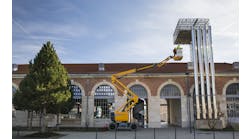Interview with Economist Ed Sullivan: Fundamentals are Strong
Edward Sullivan is chief economist for the Portland Cement Association, and has been repeatedly cited by the Chicago Federal Reserve as the most accurate forecaster regarding economic growth among 30 top economists. Sullivan has held vice president positions at Chase Manhattan Bank Economics, Standard & Poor’s and Wharton Economics and has worked for Senator Edward Kennedy and the CIA.
RER: What do you think about the new Fixing America’s Surface Transportation Act that was recently passed?
Sullivan: I’m kind of resistant to all the happiness that’s going on. We got a five-year bill, and that’s great. Did we need that? Absolutely! Does it provide the ability to do more long-term planning compared to a year-to-year kind of a fix? Absolutely it does. But don’t you dare tell me that that is sufficient, because if you look at what we were spending a few years ago, we are not spending as much. We continue to see a decline, and all it does in real dollars is slow the decline down.
Remember that that kind of commitment, that we’re all slapping each other on the back for, comes in the context that in 25 years there will be 50 million more drivers. And you tell me if that continued decline in real spending does it! I think we should applaud Congress for at least finally getting together and passing a five-year bill. But don’t be saying you addressed the nation’s infrastructure problems because you didn’t. It’s better than what we had so it’s an improvement, but we need so, so much more.
In general what do you expect from the economy in 2016 in the United States?
In 2016, we trimmed our forecast a little bit, so it’s still fundamentally strong. We saw the numbers, 211,000 jobs in November. We’ve been averaging a little better than 205,000 a month all year long. That anchors the economy, because what you’re starting to see is we’ve got job growth in the context of 5-percent unemployment. The way we count the unemployed is a little off because there are people who are under-employed. But nonetheless, you do have a market that’s firm, you do have a market that is tightening, and you have a market that’s getting ready to show some stronger wage gains than what we’ve seen. That’s very good for the consumer.
So now in terms of consumers, what does inflation look like? It’s going to grow less than ½ of a percent in 2015, and we expect it to grow to roughly 2 percent next year and while you’ve got potential for higher wage gains, you also have a stronger dollar, you also have weak global commodity markets, and you have slacks in our economy whether it be in manufacturing or how you actually do measure the market. So inflation is not going crazy. The Federal Reserve will react, they have a mandate, they probably will push interest rates up, but not big increases. Probably 25 basis points and they’ll wait quite some time before they move again because there is room for the economy to continue to expand without igniting inflationary pressures.
So interest rates will rise a little but not much. Boy, you put this in context with consumers’ debt burden being the lowest in 34 years. You look at this and you’ve got the credit quality of banks that’s the best ever. You’ve got a strong labor market, you’ve got inflation contained, you’ve got interest rates low, you’ve got improvement in the fundamentals. How can you not have a strong economy led by 3.5 percent growth in consumer spending?
Those are some strong pluses. Anything on the minus side?
You’re going to have some minuses. The minuses will be the net export position – the strong dollar makes it tough to export, and it makes imports more at risk. So there could be some pullbacks. And then on the government side, the federal government will see some continued reductions. When you hire a worker, you hire a taxpayer in state and local systems. And you’ll see expansions at that level. And it’s like 55, 60 percent of all the activity in government is state and local level, not the federal. So you see expansion there too. If we look at the whole economy, we’re comfortable. The fundamentals are there. You’ll see modest acceleration in growth, from about 2.4 percent this year (2015) to about 2.6 percent in 2016. Perhaps even stronger.
A year ago you discussed the shift to multi-family dwelling in the residential construction segment away from single-family homes? Do you continue to see momentum in that direction?
Yes, and there are a few reasons. Some are probably the same from last year, but there is a secondary reason and it comes on the supply side. So we have an economy that is expanding. Last year almost 3 million jobs were created, if there are two people in a household, we should have created about 1.5 million households. Instead we created about 700,000 so there is a disconnect between the job growth we’re seeing and household formation. And why is that? Well, look at some of the younger people coming into the labor market. When you come out with a philosophy degree, and you have $150,000 in student loan debt, it kind of dictates that you will sleep on dad’s couch, instead of forming that household. Or if you do venture out, you’re certainly not going to go out and buy a house, at least not to the rate that prior generations have. So you go out and rent. So now what you’re starting to see is that rents have pressure to rise. And in addition you have a lot of people who lost their homes from foreclosures and had their credit damaged, and they are not in a position to go out and buy. They have to rent as well.
And finally you have a [demographic] change. Year in and year out, more of us get old and a lot of us don’t want to cut the lawn anymore. If I’m going to invest in property, you know what? I’m looking at my return, and if I see nearly full occupancy, and I see my rents go up at a rate faster than inflation, boy, I think I’ll go out and invest and build more of these. So that’s what’s happening. So the economic and structural fundamentals continue to favor the multi-family and it’s more than just a cycle. It is a longer-term phenomenon.
So that’s on the demand side. And there is arguably a second issue and that revolves around supply. We shed 2.5 million construction workers during the downturn, and we are still about a million to 1.5 million below our capacity even now. When you start to look at that construction, where those workers are lost, it is much more prevalent in residential, specifically single family. Now, keep in mind, when everything turned down, we also saw Mexican-born workers decline from 1.9 to 1.4 million. We lost a half million Mexican-born workers that fled and are having a harder time coming back, so what you have is a situation, at least on the single-family side, where mom and pops are more prevalent. You’re seeing labor shortages occur in areas where demand is already starting to recover. Now we believe this is a national issue except some areas haven’t seen it or been exposed to it yet because demand hasn’t risen strongly enough. But it will. That’s another factor, you don’t see this as much on the multi-family side, and so again that’s another reason why you would expect to see the composition of stock shift to multi-family.
How do you see the construction market for 2016 – industrial construction, highway, nonresidential, residential?
A few interesting things. You see a market that we haven’t seen in quite some time, and that is for the first time in six years I believe we saw a positive for public construction. We had six years of continued and sustained decline. So now you’ve got public being positive, and it will be a bigger positive next year and the year after. In addition, non-residential. So some of those things I talked about with multi-family, that goes towards non-residential too. So if they hire a million workers, 200,000 are going to be office workers, 20 percent. That means your occupancy rate increases, your leasing rates firm, operating income increases. I can go to a bank now and show them why it makes sense to invest in office buildings. They see less risk in it and so they give me access to credit which I didn’t have before. Now buildings increase, and overall ROI is stronger. That’s what’s pushing non-residential. And it’s not just happening with offices -- whether it is hotels, or industrial, or retail; it all works. And so that, coupled with continued double-digit gains on the residential side, we’re looking for total construction activity to accelerate, from a real value basis about 9 percent this year, about 9.5 percent next year.
It’s strengthening, we see the market continue to strengthen and in our scenario, we don’t have a break in economic growth, and so all these things that we talk about that are going to propel growth next year, they continue throughout the forecast. They just ease in terms of the rate of increases that you see.
Your readers are going to say, “Come on, 9 percent? Nine percent on top of 9 percent? You’re crazy!” Wow! What you got to realize is the depth of the decline, 9 percent coming off nothing is still relatively small. But that is what is critically important when you look at these things because we have construction rising 9 percent, 9.5, 7, 5, 5, and you know what? After all those big percentage increases, we aren’t anywhere near the past cyclical peak.
What do you expect from the oil-and-gas market in 2016 in terms of oil prices? How will this market impact construction and the economy as a whole?
Number one, I believe the oil market is still searching for a bottom. Oil prices are extremely difficult to project or forecast. So the Energy Information Administration, that’s the government, they have teams of economists working on this, they believe oil prices will increase in 2016. So they have the market average going up to $54. A lot of people would argue that $40 would be the better number. Having said that, what we’ve seen is that oil prices have both positive and negative impact on the economy and on construction.
So think about it: Oil prices go down. If I’m a producer, I cut back my drilling and exploration immediately. I lay off people. If I’m in North Dakota and I lay off people, you don’t have to keep building that 7-11 down the street because people are going. You don’t have to continue building that multi-family. It has secondary impacts that are felt immediately. We do an estimate for cement consumption, oil well cement consumption. For every 1 ton loss of oil well cement, you lose 2.9 tons elsewhere, whether that would be paving a road, building a commercial store, or multi-family or office building, whatever. It has a multiple impact. The less diverse the economy is, like a North Dakota, like Texas, it has an even greater impact, as much as 10 to 1. So adverse impact immediately felt.
When all the fracking and oil activity was at its boom, there was an underestimation in terms of the positive influence that had on the overall economy. We underestimated its positive impact. And they’ve since done studies in terms of labor, what they call labor multipliers. You create a job in energy and maybe that creates five jobs downstream. Well they did an update on that recently and it’s one job in energy, 10 jobs elsewhere. In other words, doubling that potential impact. Now you reverse that, you take away a job, you just took away 10 jobs. It has an adverse impact and does slow down the economy greater than we thought. Again that’s one of the reasons why we lowered our GDP estimates.
So those are the negatives, but there’s good stuff. You lower oil prices; I’m not paying as much at the pump. But if you think about it, you’re not going to go out and buy a new TV because you save $20 at the pump. It takes a while for you to recognize it and actually change your spending habits. And you have to be convinced that it’s permanent.
So far we really haven’t seen that dramatic increase yet. And it’s a long lag period. Think about what this means. If that means you actually are going to increase amount of spending activity because of low oil prices in the economy, consumers get stronger. Consumers get stronger, GDP gets stronger. GDP is stronger, construction activity is stronger. That’s a long string, but it works. But it works in delayed fashion and it is a very small impact in terms of overall construction. If you look at the net impact on oil, it is much more near-term, front-loaded, and negative. So as the oil prices turned, all those negatives start to unwind and eventually become a positive. So if you look at what the EIA is saying now, it’s by 2020, it goes from 2015 $49-$53 a barrel to $83 in 2020. Because we’re talking change now, you will have oil as a sustained positive impact to near-term impact on construction.
How will the slowdown in China impact the construction market and economy in North America?
China has the second largest economy in the world, and instead of having the expectation of 7 percent growth, people, depending on who you believe, see it as struggling to even get 5.5. That has a pretty big impact on commodity prices. They are a principal reason why oil prices are low. There are supply factors, no question, but the demand factor is huge and it’s not just that it’s also on other commodities, it’s also on shipping. If China has a lot of cement and excess capacity, there are a lot of ships available. They can land that elsewhere around the globe rather cheap. And because the United States is the strongest economy now, the dollar regains strength and that makes imports even cheaper.
So when you look at China, does it have an impact on us? Yes it does. And one of the areas we’re going to see it is in a widening trade deficit, and the argument is that can keep inflation down but it also will temper the improvement in the job market.
Regionally, what do you expect from the construction market in North America?
There are two ways to look at this. From peak to trough, the peak in 2004-05 down to the trough in 2009, places that really got hit were the coasts. That’s where the home price escalation was and that’s where you had a greater proportion of people using the exotic mortgages, that’s where you’re having the economy’s biggest structural corrections. It takes a while. If we compare the recession to cutting your hand, the deeper the cut, the longer it takes to heal. The interior of the United States didn’t participate in this huge ramp-up in home prices; it didn’t participate as greatly in the exotic mortgages. Their economies were better anchored in agriculture and energy. So you didn’t have as big of a disruption in terms of the job losses. So it’s pretty clear that over the last few years, the central portion of the United States came back quicker.
Now as you get into the second stage of this whole recovery process, which you’re now starting to see as the growth phase, the improvement in the central portion of the United States is slowing, because they already at or near the past cycle peaks. They recovered faster, and you’re starting to see that the coastal areas are seeing growth accelerate because the healing process has reached a point where they are now starting to get up off the mat and they have a long way to go, so this is what we’re starting to see, the job growth, the state GDP is growing at faster rates on the coasts. We’re expecting that construction activity follows that.
So areas like New England are doing well, the mid-Atlantic, the south Atlantic is starting to with the exception of Florida, and even Florida in certain regions. You’re starting to see pickups, significant percentage gains in the Southwest, again significant percentage gains from the depths to which they fell. We are starting to see growth rates accelerating in areas that got hit hardest, they are now coming up off the mat, where let’s say a year or two ago you could make the argument that they weren’t coming up off the mat yet.
Are there any major concerns that could derail the economic recovery?
There are several things. First of all, I would say on a less concerning basis, there’s the issue that if you have the United States as the only stable area globally, how long can you sustain that as an island by yourself? There’s potential out there that the global weakness could permeate our economy and slow it down. I don’t put an awful lot of weight into that risk but it’s out there. The second thing is, I think the fundamentals are very good overall in supporting construction, but some strange data shows up. If you look at Dodge contract awards, the last six months they’re down almost 30 percent. I think it’s the biggest decline since 2008. But some people argue that contract awards can be suggestive as to what happens to construction activity given a timeline.
The Dodge data was peculiar in that private and public declined at rough proportions and back in 2007 and ‘08 when you started to see contract awards decline, private took a huge hit, while public was very slow and gradual. The private sector is going to react if there’s some problem in the economy. Public is slow to react. So right now we’re aware of this discrepancy, this oddity, we’re not sure how to explain it, though we have some ideas. We’re keeping our eye on it but we’re dismissing it right now as a data anomaly. So that’s one issue.
But there are a lot of risks in the forecast. I can tell you that one of our forecasts issues also is the whole highway bill. I think there’s an upside risk. We talked about that it didn’t go that far. There’s another issue too that as you expand the federal spend, the states cut back. We call this sterilization and there will be some sterilization. [The highway bill is] a net contributor to construction compared to what our previous assumptions were, but it may not be quite as much as some people think because of the existence of the sterilization impact.
